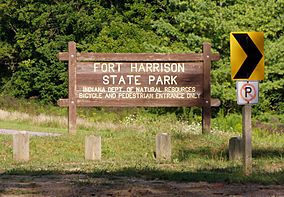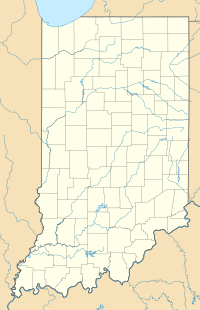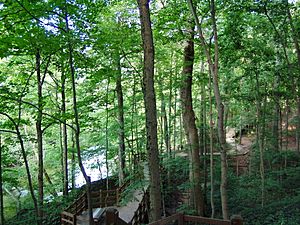Fort Harrison State Park facts for kids
Quick facts for kids Fort Harrison State Park |
|
|---|---|
|
IUCN Category III (Natural Monument)
|
|
 |
|
| Location | Marion County, Indiana, USA |
| Nearest city | Lawrence, Indiana |
| Area | 1,700 acres (6.9 km2) |
| Established | 1996 |
| Visitors | 889,232 (in 2018–2019) |
| Governing body | Indiana Department of Natural Resources |
| Fort Harrison State Park | |
Fort Harrison State Park, often called Fort Ben, is a super cool Indiana state park located in Lawrence, Indiana. It's built on part of an old military base called Fort Benjamin Harrison. Today, it's a fantastic place for outdoor fun!
The park has lots of history, including areas that were once a training camp for citizens, a camp for young workers during the Great Depression, and even a camp for prisoners during World War II. You can enjoy picnics, go for walks, or jog on its many trails. There's even a path that connects to the Fall Creek Greenway. Almost 900,000 people visit Fort Harrison State Park every year!
In April 2024, the park was a perfect spot to see a total solar eclipse! Visitors enjoyed nearly four minutes of darkness as the moon completely blocked the sun.
Contents
A Look Back: Fort Harrison's Story
How Fort Harrison Began
President Theodore Roosevelt officially opened Fort Harrison in 1906. It was named to honor another former president, Benjamin Harrison, who was from Indianapolis. Benjamin Harrison's son, Russell Harrison, wanted to make sure a military base stayed in Indianapolis. So, in 1904, the government bought land about 9 miles (14 km) from downtown Indianapolis to build the fort.
Building the Fort
By 1908, the fort was ready! It had brick buildings for soldiers to live in (called barracks), offices, homes for officers, and a hospital. There were even stables for horses. The Tenth Infantry Regiment was the first group of soldiers to move into the new facilities.
Fort Harrison's Military Role
Fort Harrison was important because it was one of the first places to help create a national army by using soldiers from state militias. It served as a training ground, a support center for soldiers, and a place to welcome troops. It was active during many major events, from World War I all the way to Operation: Desert Storm. During World War II, it even had a camp for prisoners of war.
In the 1980s, the area around Fort Harrison started to become home to many people of Asian and Hispanic backgrounds.
The Pan American Games
In 1987, Fort Benjamin Harrison hosted the athlete village for the 1987 Pan American Games. Special buildings were put up for dining, lodging, and practice areas for the athletes.

Becoming a State Park
After the Cold War ended, the United States government decided to close some military bases. Fort Harrison in Indianapolis was one of them, closing in 1991. The base had many cool features, like an officers' club, special homes for important visitors, and an 18-hole golf course. It also had one of the largest hardwood forests in central Indiana.
In 1995, the U.S. Department of the Interior decided to give 1,700 acres (6.9 km2) of the old fort's land to the Indiana Department of Natural Resources. This land was then turned into a state park, just like Charlestown State Park in southern Indiana.
A Governor's Home
In 2003, while the Indiana Governor's Mansion was being updated, Governor Frank O'Bannon and his wife lived at the Harrison House. This building, now an inn within the park, used to be a nurses' dorm during World War II and later a special home for VIPs. They lived there for most of the year until the mansion was ready. After they moved out, the Harrison House became available for everyone to enjoy.
Future Plans
There are plans to move the historic Bell Ford Bridge from Jackson County, Indiana, into the park. This would create another way for people to walk and bike across Fall Creek.
What to Do at Fort Harrison State Park
Fun Activities and Trails
Fort Harrison is different from most Indiana state parks because it's mainly for day visits. The only places to stay overnight are The Fort Golf Resort, which used to be the officers' club, and the Harrison House Suites. The park's 18-hole golf course is very popular with golfers. It was redesigned by a famous golf course architect, Pete Dye, and is a 72-par course.
The park has six different hiking trails and one trail for horseback riding. You can even rent horses there! One of the hiking trails, the Harrison Trace Trail, is paved, making it perfect for bikers and rollerbladers. The longest trail is the Lawrence Creek Trail, a 4.2-mile (6.8 km) path for mountain biking and walking. Instead of steep hills, you'll see beautiful wildflowers. You can also go fishing, but remember to buy a state fishing permit at the park office. In winter, you can even try ice fishing!
Nature and Wildlife
Fall Creek flows for about 3.5 miles (5.6 km) through the park, with smaller streams joining it. You might spot beavers, deer, frogs, squirrels, and turtles. There's also a special pond where herons live, but visitors aren't allowed to go there to protect the birds. The park office has an interpretive center where you can learn all about the park's history and its amazing natural environment.
Museum of 20th Century Warfare
The Museum of 20th Century Warfare is located in Building 711, in the historic Camp Glenn area of the park. It has cool exhibits about the fort, military technology, old artifacts, uniforms, and stories of soldiers from the 1900s. A 14-foot (4.3 m) model of the USS Indianapolis ship is a permanent display. The museum also changes its temporary exhibits every three months. They even have special events like re-enactments and living history camps. You only pay the park entrance fee to visit the museum.
See also



